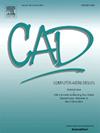Topo-GenMeta: Generative design of metamaterials based on diffusion model with attention to topology
IF 3.1
3区 计算机科学
Q2 COMPUTER SCIENCE, SOFTWARE ENGINEERING
引用次数: 0
Abstract
Metamaterials are a family of artificial materials that achieve unique properties by designing the shape of unit cell structures. Expanding the metamaterial unit cell library is a key focus in this field, with the aim of enhancing the design flexibility to meet multifunctional requirements across diverse physical scenarios. Recent advancements in data-driven generative techniques using deep learning have significantly sped up innovations in metamaterial design. However, existing approaches mostly focus on the geometric characteristics of unit structures without considering their topological properties explicitly, which we believe are essential for enhancing design diversity and enriching material properties. In this study, we propose a novel data-driven metamaterial design methodology that combines the denoising diffusion probabilistic model with the persistent homology technique. Our model is capable of generating high-fidelity and functionally effective unit structures. Furthermore, by incorporating topological properties derived from persistent homology into the diffusion process, our method facilitates the generation of a diversity of metamaterial unit structures with richer shapes and properties. To the best of our knowledge, this is the first approach to explicitly consider topological properties in metamaterial design. In addition, our method also supports multi-scale design applications, enabling the generation of metamaterial units that align with the desired properties to achieve the optimization objectives.
Topo-GenMeta:基于关注拓扑的扩散模型的超材料生成设计
超材料是一类人工材料,通过设计单细胞结构的形状来实现独特的性能。扩展超材料单元胞库是该领域的一个关键焦点,其目的是提高设计灵活性,以满足不同物理场景的多功能需求。使用深度学习的数据驱动生成技术的最新进展大大加快了超材料设计的创新。然而,现有的方法大多侧重于单元结构的几何特征,而没有明确考虑其拓扑特性,我们认为这对于增强设计多样性和丰富材料特性至关重要。在这项研究中,我们提出了一种新的数据驱动的超材料设计方法,该方法将去噪扩散概率模型与持续同源技术相结合。我们的模型能够生成高保真度和功能有效的单元结构。此外,通过将源自持续同源的拓扑性质结合到扩散过程中,我们的方法有助于生成具有更丰富形状和性质的多种超材料单元结构。据我们所知,这是第一个在超材料设计中明确考虑拓扑特性的方法。此外,我们的方法还支持多尺度设计应用,能够生成与所需属性一致的超材料单元,以实现优化目标。
本文章由计算机程序翻译,如有差异,请以英文原文为准。
求助全文
约1分钟内获得全文
求助全文
来源期刊

Computer-Aided Design
工程技术-计算机:软件工程
CiteScore
5.50
自引率
4.70%
发文量
117
审稿时长
4.2 months
期刊介绍:
Computer-Aided Design is a leading international journal that provides academia and industry with key papers on research and developments in the application of computers to design.
Computer-Aided Design invites papers reporting new research, as well as novel or particularly significant applications, within a wide range of topics, spanning all stages of design process from concept creation to manufacture and beyond.
 求助内容:
求助内容: 应助结果提醒方式:
应助结果提醒方式:


